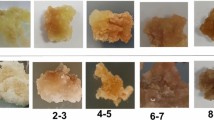Abstract
Haematococcus pluvialis is a unicellular green alga which produces a ketocarotenoid, astaxanthin which has pharmaceutical and nutraceutical applications owing to its high antioxidant activity. Biotechnological approaches such as genetic transformation methods (Agrobacterium-mediated) and cloning strategies, are essential to improve/regulate this ketocarotenoid in Haematococcus. For this studies are necessary to improve Haematococcus through biotechnological means. In this connection, a suitable cocultivation medium for Haematococcus and Agrobacterium tumefaciens was standardized and different antibiotics were screened. Among the cocultivation media viz Z8, Bold’s Basal Medium, Tris Acetate Phosphate Z8 with 0.5% mannitol and BBM and Z8 with half strength LB TAP medium was found suitable for growth of both the alga Haematococcus and Agrobacterium. For the different antibiotics screened to identify the sensitivity of algae, hygromycin at more than 2 mg L−1 showed lethal effect which can be used as a selectable marker gene in genetic transformation, whereas cefotaxime and augmentin showed no effect up to 2,000 mg L−1. The growth of algae was higher in solid selection medium when compared to the liquid selection medium.



Similar content being viewed by others
References
Berthold P, Schmitt R, Mages W (2002) An engineered Streptomyces hygroscopicus aph 7″ gene mediates dominant resistance against hygromycin B in Chlamydomonas reinhardtii. Protist 153:401–412 doi:10.1078/14344610260450136
Boussiba S, Vonshak A (1991) Astaxanthin accumulation in the green alga Haematococcus pluvialis. Plant Cell Physiol 32:1077–1082
Brown LE, Sprecher SL, Keller LR (1991) Introduction of exogenous DNA into Chlamydomonas reinhardtii by electroporation. Mol Cell Biol 11:2328–2332
Dawson HN, Burlingame R, Cannons AC (1997) Stable transformation of Chlorella: rescue of nitrate reductase-deficient mutants with the nitrate reductase gene. Curr Microbiol 35:356–362 doi:10.1007/s002849900268
Goodwin TW (1980) The biochemistry of the carotenoids. Vol I. Plants Eds Chapman and Hall, London, p 377
Guerin M, Huntley ME, Olaizola M (2003) Haematococcus astaxanthin: applications for human health and nutrition. Trends Biotechnol 21:210–216 doi:10.1016/S0167-7799(03)00078-7
Harris EH (1989) The Chlamydomonas source book: a comprehensive guide to biology and laboratory use. Academic, San Diego, USA
Higuera-Ciapara I, Felix-Valenzuela I, Goycoolea FM (2006) Astaxanthin: a review of its chemistry and applications. Crit Rev Food Sci Nutr 46:185–196 doi:10.1080/10408690590957188
Kumar SV, Rajam MV (2007) Induction of Agrobacterium tumefaciens vir genes by the green alga, Chlamydomonas reinhardtii. Curr Sci 92:1727–1729
Kumar SV, Misquitta RW, Reddy VS, Rao BJ, Rajam MV (2004) Genetic transformation of the green alga—Chlamydomonas reinhardtii by Agrobacterium tumefaciens. Plant Sci 166:731–738 doi:10.1016/j.plantsci.2003.11.012
Ladygin VG (2004) Efficient transformation of mutant cells of Chlamydomonas reinhardtii by electroporation. Process Biochem 39:1685–1691 doi:10.1016/j.procbio.2003.07.001
Lagarde D, Beuf L, Vermaas W (2000) Increased production of zeaxanthin and other pigments by application of genetic engineering techniques to Synechocystic sp. Strain PCC 6803. Appl Environ Microbiol 66:64–72
Lin JJ, Ma J, Garcia-Assad N, Kuo J (1996) Hygromycin as an efficient antibiotic for the selection of transgenic plants. Focus 18:47–49
Maruyama M, Horakova I, Honda H, Xing X, Shiragami N, Unno H (1994) Introduction of foreign DNA into Chlorella saccharophila by electroporation. Biotechnol Tech 8:821–826 doi:10.1007/BF00152891
Ortiz JPA, Reggiardo MI, Ravizzini RA, Altabe SG, Cervigni GDL, Spitteler MA, Morata MM, Elias FE, Vellegos RH (1996) Hygromycin resistance as an efficient selectable marker for wheat stable transformation. Plant Cell Rep 15:877–881 doi:10.1007/BF00231579
Schell J, Herrera-Estrella L, Zambryski P, DeBlock M, Joos H, Willmitzer L, Eches P, Rosahl S, Van Montagu M (1984) Genetic engineering of plants. In: Schell JS, Starlinger P (eds) The impact of gene transfer technique in eukaryotic cell biology. Springer, Berlin, pp 73–90
Schiedlmeier B, Schmitt R, Muller W, Kirk MM, Gruber H, Mages W, Kirk DL (1994) Nuclear transformation of Volvox carteri. Proc Natl Acad Sci U S A 91:5080–5084 doi:10.1073/pnas.91.11.5080
Sivonen K, Kononen K, Esala AL, Niemela SI (1989) Toxicity and isolation of cyanobacterium Nodularia spumigena from the southern Baltic sea in 1986. Hydrobiologia 185:3–8 doi:10.1007/BF00006062
Steinbrenner J, Sandmann G (2006) Transformation of the green alga Haematococcus pluvialis with a phytoene desaturase for accelerated astaxanthin biosynthesis. Appl Environ Microbiol 72:7477–7484 doi:10.1128/AEM.01461-06
Teng C, Qin S, Liu J, Yu D, Liang C, Tseng C (2002) Transient expression of lacZ in bombarded unicellular green alga Haematococcus pluvialis. J Appl Phycol 14:495–500 doi:10.1023/A:1022314815045
Travella S, Ross SM, Harden J, Everett C, Snape JW, Harwood WA (2005) Comparison of transgenic barley lines produced by particle bombardment and Agrobacterium-mediated techniques. Plant Cell Rep 23:780–789 doi:10.1007/s00299-004-0892-x
Acknowledgements
The authors thank Dr. V. Prakash, Director, Central Food Technological Research Institute for his support to carry out this work and acknowledge the Council for Scientific and Industrial Research and Department of Science and Technology for their financial support.
Author information
Authors and Affiliations
Corresponding author
Rights and permissions
About this article
Cite this article
Kathiresan, S., Sarada, R. Towards genetic improvement of commercially important microalga Haematococcus pluvialis for biotech applications. J Appl Phycol 21, 553–558 (2009). https://doi.org/10.1007/s10811-009-9414-0
Received:
Revised:
Accepted:
Published:
Issue Date:
DOI: https://doi.org/10.1007/s10811-009-9414-0




